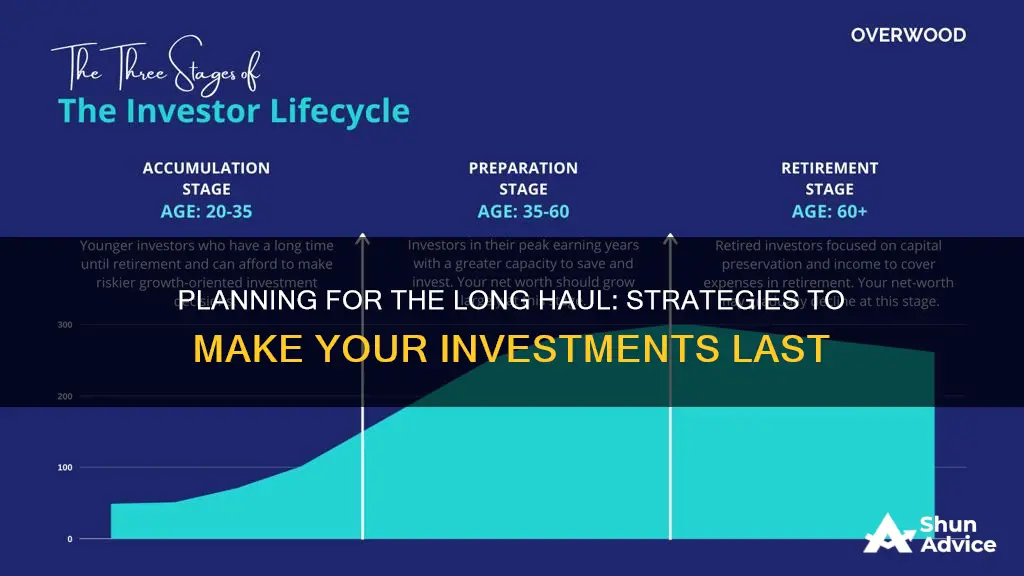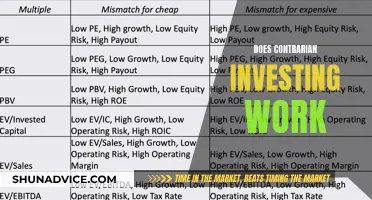
How long an investment will last depends on a variety of factors, including the type of investment, market performance, and individual circumstances. For example, in the context of retirement planning, the longevity of savings is influenced by factors such as investment returns, inflation, and unexpected expenses. To estimate how long their money will last, individuals can weigh their total savings and investment returns against annual expenses, using online calculators and financial advisors. Additionally, withdrawal strategies, such as the 4% rule, dynamic withdrawals, and the income floor strategy, can help extend retirement savings.
| Characteristics | Values |
|---|---|
| Determining Factors | Total savings, investment returns over time, annual expenses, inflation, unforeseen expenses |
| William Benger's Theory | If 50% of money is invested in stocks and the rest in bonds, there is a strong likelihood of withdrawing an inflation-adjusted 4% of savings every year for 30 years |
| Dynamic Withdrawals | Change your withdrawal amount in response to investment returns |
| Income Floor Strategy | Cover essential expenses with guaranteed income, such as Social Security, plus a bond ladder or an annuity |
What You'll Learn

Systematic withdrawals
A systematic withdrawal plan (SWP) is a scheduled investment withdrawal plan that is typically used in retirement. It is a disciplined method of using an investment and can simplify personal money management, especially in retirement. It can also help you avoid tax issues.
To keep your asset allocation in balance, you can sell shares proportionately across funds, opt for one balanced fund, or use a retirement income fund. You can also opt for systematic withdrawals based on a percentage instead of a set amount to reduce losses during a down market.
Here's an example: Let's say you own three mutual funds. You have 50% of your money in ABC fund, 30% in XYZ fund, and 20% in QRS fund. If you wanted to set up a $1,000 monthly systematic withdrawal, your withdrawal would be split across all three funds. So, 50% of your withdrawal amount ($500) would come from ABC, 30% ($300) from XYZ, and 20% ($200) from QRS.
Instead of using several funds, you could also use one balanced fund and take systematic withdrawals from that. Or, you could use a retirement income fund that's managed specifically to provide you with monthly income.
A systematic withdrawal plan is designed to be the opposite of risky. By using a pre-planned and specified system for taking distributions from your account, you can manage the risk beforehand and course-correct accordingly. However, there is one potential downside: more shares must be liquidated to meet your withdrawal needs during times when your investments are down in value.
In a market correction or bear market, this can have the reverse effect of a dollar-cost averaging strategy, lowering your overall internal rate of return when compared to other withdrawal strategies. To overcome this, you might consider withdrawing a percentage instead of a set amount. In this way, you will receive less, but when the market swings back up, the value of your assets will increase along with the withdrawal amounts because you have held on to more shares.
Solar's Dark Side: The Shady Truth About Investing in Sunshine
You may want to see also

Inflation
The impact of inflation on investments is twofold. Firstly, inflation erodes the real value of money over time. This means that even if your investment generates a profit, that profit may not be enough to keep up with rising prices, resulting in a loss of purchasing power. For example, an investment of $100,000 in 1980 would be worth approximately $359,600 in today's money. However, due to inflation, the purchasing power of that amount has decreased significantly. Secondly, inflation can also affect the returns on investments. For instance, if a bank lends money at a fixed interest rate, a high inflation rate could reduce the real income earned from that loan.
The impact of inflation on investments is not always negative, however. In the case of retirement accounts such as 401(k)s and IRAs, contribution limits are often adjusted for inflation, allowing individuals to save more during periods of high inflation. Additionally, high inflation rates can lead to a decrease in tax burdens, as tax brackets and standard deductions are typically adjusted for inflation as well.
The longevity of inflation is difficult to predict, but various indicators and expert opinions can provide some insight. In May 2021, CNBC polled 30 market strategists, with 21 of them believing that inflation is temporary, while nine predicted a long-term sustained rise in consumer prices. A Natixis research paper from November 2023 supports the view that disinflation is making steady progress, and that it will endure for at least the next several years. Government officials from the International Monetary Fund expected the US inflation rate to reach its 2% target by the end of 2023, but this prediction has not yet come to pass.
In summary, while no one can say with certainty how long inflation will last, it is clear that it has a significant impact on investments and the overall economy.
Smart Places to Invest $60K Today
You may want to see also

Investment returns
There are several types of returns to consider:
- Holding period return: This is the return earned over the time an investment is held and can be expressed nominally or as a percentage (rate of return).
- Annual return: This calculates the price change from the current date to the same date one year ago.
- Nominal return: This is the net profit or loss of an investment in dollar value before any adjustments for taxes, fees, inflation, or other factors.
- Real rate of return: This adjusts the nominal return for changes in prices due to inflation or other external factors, providing a more accurate picture of the investment's value over time.
- Total return: For stocks, this includes both price change and dividend and interest payments.
- Percentage return or Return on Investment (ROI): This expresses the return as a percentage of the initial investment.
- Gross return: This is the absolute change in price plus any income generated by the investment over a given period.
- Net return: This takes the gross return and subtracts any commissions, management fees, taxes, or other expenses. It represents the actual profit or loss from the investment.
When calculating investment returns, it's important to consider factors such as risk tolerance, investment capital, rate of return, inflation, taxes, and time horizon. These factors can impact the longevity of your investment returns and overall financial goals.
Diversifying Savings: Beyond Stocks and Bonds
You may want to see also

Annual expenses
When it comes to annual expenses, there are a few strategies you can use to make your savings last longer. Here are some approaches to consider:
The 4% Rule
The 4% rule is a well-known strategy that involves withdrawing 4% of your savings in the first year of retirement and then adjusting for inflation in subsequent years. This strategy is based on research by William Benger, who found that investing at least 50% of your money in stocks and the rest in bonds would allow you to safely withdraw an inflation-adjusted 4% of your savings annually for 30 years or more. This rule has been tested during some of the worst financial markets in history, including the Great Depression, and has been shown to be a safe withdrawal rate.
Dynamic Withdrawals
Dynamic withdrawal strategies are more flexible than the 4% rule as they take into account the performance of the market. With these strategies, you adjust your withdrawal amount each year based on your investment returns. This means that in good market years, you can withdraw more, and in bad market years, you withdraw less. Dynamic withdrawal strategies can be more complex, and it may be helpful to consult a financial advisor when setting one up.
The Income Floor Strategy
The income floor strategy helps ensure that your basic expenses are covered by guaranteed income sources, such as Social Security, bond ladders, or annuities. This way, you don't have to worry about selling stocks when the market is down, and you know that your essential needs will be met. This strategy can provide peace of mind and help make your savings last longer.
Reducing Fixed Expenses
One of the most effective ways to make your savings last longer is to reduce your fixed expenses. For many people, their mortgage is their largest expense. Downsizing to a smaller home can reduce mortgage and property tax costs, as well as lower utility and insurance costs. This strategy not only saves money but can also simplify your life and reduce stress.
Understanding Essential vs. Discretionary Expenses
It's important to differentiate between what you absolutely need to pay for (essential expenses) and what you want (discretionary expenses). Essential expenses include food, housing, and healthcare, while discretionary expenses might include vacations, cars, and eating out. As your income may drop in retirement, it's crucial to prioritize your essential expenses and be mindful of your discretionary spending to ensure your savings last longer.
Mortgage Freedom or Monthly Investment: The Great Financial Debate
You may want to see also

Dynamic withdrawal strategies
There are many dynamic withdrawal strategies, each with varying degrees of complexity. Here are some examples:
- T. Rowe Price's approach: This strategy suggests taking static inflation-adjusted withdrawals, similar to the 4% rule, but dropping the inflation adjustment any year following a substantial market downturn that shrinks your portfolio. This approach allows you to begin retirement with a higher withdrawal rate than those who insist on taking inflation adjustments annually, regardless of market performance.
- Small-but-permanent cuts: This strategy involves making smaller but permanent cuts to your spending, smoothing out consumption and providing less dramatic swings in annual spending. For example, a retiree could take a 1% (real) cut that is permanent over their entire retirement horizon. If inflation was 3% for a given year, and the market was down the previous year, the retiree would only take a roughly 2% increase in spending the next year. A more significant permanent cut of 3% whenever the market is negative can boost the initial withdrawal rate by over 0.5%.
- Large-but-temporary cuts: This strategy involves making larger but temporary cuts to your spending. For example, a retiree could commit to cutting spending by 10% for one year after a market decline of 20%. However, this strategy has a minimal impact on boosting spending throughout retirement, as annual declines of 20% are relatively uncommon.
- Wade Pfau's approach: Wade Pfau has studied different variable spending strategies and their impact on retirement income and initial withdrawal rates. He found that if retirees are willing to be flexible with their spending, a somewhat higher initial withdrawal rate may be feasible.
It is important to note that dynamic methods can be complex and may require hands-on management. Consulting a financial advisor or retirement planner is recommended to explore these options and determine the best strategy for your needs.
The Debt-Equity Dilemma: Navigating the Payoff Crossroads
You may want to see also
Frequently asked questions
This will depend on a number of factors, including your total savings, investment returns, annual expenses, inflation, and unforeseen expenses. You can use an online calculator to get a rough estimate.
The 4% rule states that you take out 4% of your savings in the first year of retirement, and then that same dollar amount plus an inflation adjustment every year after that. Research has found that if you invest at least 50% of your money in stocks and the rest in bonds, you can safely withdraw an inflation-adjusted 4% of your savings every year for 30 years.
Dynamic withdrawals are a strategy that takes into account the performance of the market. With this strategy, you change the amount you withdraw in response to investment returns.







